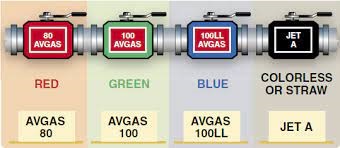Lead is a toxic metal that has already been banned in paint and other products found in and around our homes. Lead also can be emitted into the air from industrial sources and leaded aviation gasoline, and lead can enter drinking water from plumbing materials. Lead may cause a range of health effects, from behavioral problems and learning disabilities, to seizures and death. Children six years old and under are most at risk.

Lead emitted from aircraft using leaded aviation gasoline (avgas) is currently the largest source of lead in air in the United States, constituting about 50% of lead emissions in the 2005 National Emissions Inventory [U.S. Environmental Protection Agency (EPA) 2010]. Although leaded gasoline for automobiles was phased out of use in the United States by 1995, lead is still permitted in avgas. Lead is added to avgas to achieve the high octane required for the engines of piston-driven airplanes.
Previous research indicates that children’s’ blood lead levels increase near airports. A study at the Santa Monica Airport in California found lead levels to be significantly higher than background levels in a residential neighborhood close to the airport runway. Thus, the combustion of leaded avgas by small airplane engines may pose a health risk to children who live or attend school near airports. The lead in air surrounding airports can be inhaled directly, or the lead may be ingested by children after it settles into soil or dust (U.S. EPA 2010).
The U.S. EPA estimates that people living within 1 km of airports are at risk of being exposed to lead from avgas (Hitchings 2010). The U.S. EPA further notes that about 16 million people live within 1 km of an airport with planes using avgas, and 3 million children attend school within 1 km of these airports (U.S. EPA 2010). So why isn’t the EPA doing anything to protect these 19 million people. Tell the EPA to get the lead out of their pants and the planes and to do their job. It can be done, it should be done, and with your help it will be fast tracked.
- https://www.rosevilletoday.com/press-releases/santa-clara-county-seeks-national-ban-of-leaded-aviation-gasoline/
- https://countyairports.sccgov.org/resources/airborne-lead
- https://californianewstimes.com/lead-contamination-discovery-results-in-santa-clara-supervisors-decision-to-close-reid-hillview-in-januar/489403/
- https://www.kqed.org/news/11883910/a-crisis-on-our-hands-children-near-san-joses-reid-hillview-airport-exposed-to-dangerously-high-lead-levels-new-study-shows
Fuel Specific Documents and Sites of Interest
- AVGAS Facts and Future – Shell
- FAA Issues Request for Unleaded Replacement for General Aviation Gasoline (Avgas) 06/10/2013
EPA’s Data and Analysis of Piston-Engine Aircraft Emissions of Lead at U.S. Airports
The EPA is evaluating the air quality impact of lead emissions from aircraft using leaded aviation gasoline as described in the Federal Lead Action Plan to Reduce Childhood Lead Exposures and Associated Health Impacts and in response to the petitioner’s requests.
The materials provided below describe methods to calculate airport lead inventories, fact sheets on air quality monitoring at airports, a report and fact sheet on model-extrapolated estimates of lead concentrations at airports, and estimates of the number of people who live near or attend school near airports.
- Fact Sheet: Technical Update for Reports on the Impact of Lead Emissions from Piston-Engine Aircraft on Air Quality Near U.S. Airports (PDF)
- Model-extrapolated Estimates of Airborne Lead Concentrations at U.S. Airports (PDF)
- National Analysis of the Populations Residing Near or Attending School Near U.S. Airports (PDF)
- This and more information may be found on the EPA website: https://www.epa.gov/regulations-emissions-vehicles-and-engines/epas-data-and-analysis-piston-engine-aircraft-emissions
Following is a list of additional documents related to the ongoing study of airborne lead at airports and the development of unleaded aviation fuel.
- Fact Sheet, Final Revisions To The National Ambient Air Quality Standards for Lead
EPA (2008) - Fact Sheet, Revisions to Lead Ambient Air Monitoring Requirements
EPA (2010) - Fact Sheet, Decision National Ambient Air Quality Standards For Lead
EPA (2016) - Interim Guidance on Mitigating Public Risks Associated With Lead Emissions from Avgas
FAA (2013) - A Geospatial Analysis of the Effects of Aviation Gasoline on Childhood Blood Lead Levels
Miranda, Anthopolos and Hastings (2011) - Environmental Health Perspectives
- The Effect of Leaded Aviation Gasoline on Blood Lead in Children
Sammy Zahran, Terrence Iverson, Shawn P. McE.murry, Stephan Weiler (2017)
- Selection of Airports for the Airport Monitoring Study
Marion Hoyer, Meredity Pedde, EPA (2010) - Development and Evaluation of an Air Quality Modeling Approach for Lead Emissions from Piston-Engine Aircraft Operating on Leaded Aviation Gasoline
EPA (2010) - Calculating Piston-Engine Aircraft Airport Inventories for Lead for the 2008 National Emissions Inventory
EPA (2010) - Lead Emissions from the Use of Leaded Aviation Gasoline in the United States, Technical Support Document
EPA (2008) - Technical Note – Lead (Pb) Ambient Air Monitoring Network Design Issues
EPA (2009) - FAA Website – About Aviation Gasoline
- EPA Website – Regulations for Lead Emissions from Aircraft
- EPA Website – EPA’s Data and Analysis of Piston-engine Aircraft Emissions of Lead at U.S. Airports
- Website – EPA’s 2009-2010 Lead Modeling Study at the Santa Monica Airport
2018 Public Comments
All public comments received regarding the perceived hazards associated with leaded aviation gasoline are provided below.
Anissa Mohler 12/02/2018
California Pilots Association 12/02/2018
SCAPA EPA Lead Monitoring at the San Carlos Airport 04/20/2015

